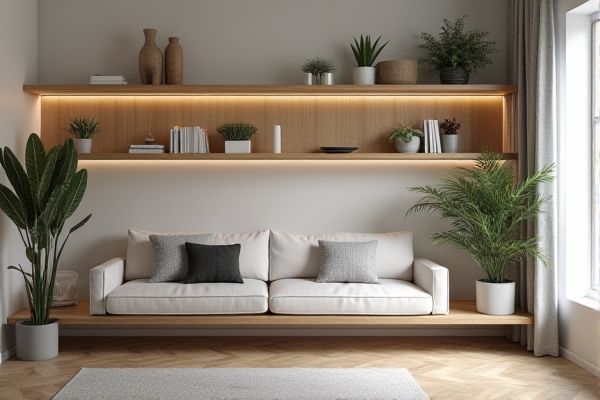
A swing-shelf system offers enhanced accessibility and space-saving benefits compared to a fixed-shelf system, allowing you to easily reach items stored in deep or corner cabinets without removing shelves. Explore the detailed comparison to understand which shelving solution best suits your storage needs.
Table of Comparison
| Feature | Swing-Shelf System | Fixed-Shelf System |
|---|---|---|
| Flexibility | Highly adjustable, shelves swing out for easy access | Static, shelves are fixed in place |
| Ease of Access | Enhanced accessibility, ideal for corner cabinets | Limited access, often requires reaching over items |
| Installation | Requires additional hardware and space for movement | Simple to install with standard shelf supports |
| Durability | Mechanisms may wear over time, moderate durability | High durability, fewer moving parts |
| Cost | Generally higher due to complexity and hardware | Lower cost, minimal components |
| Ideal Use | Best for maximizing corner storage and accessibility | Suitable for standard storage needs |
Introduction to Swing-Shelf and Fixed-Shelf Systems
Swing-shelf systems offer enhanced accessibility by allowing shelves to pivot outward, making it easier to reach items stored deep within cabinets. Fixed-shelf systems provide a stable, stationary storage solution ideal for organizing heavier or frequently used items with consistent accessibility. Your choice between swing-shelf and fixed-shelf systems depends on the need for convenience, space optimization, and the type of items you plan to store.
Key Design Differences
Swing-shelf systems offer flexible access by allowing shelves to pivot outward, enhancing visibility and reach of stored items, unlike fixed-shelf systems which remain stationary and limit accessibility. Fixed shelves provide stability and are typically more cost-effective, ideal for heavy or bulky items, whereas swing shelves prioritize user convenience in tight spaces. Your choice depends on balancing the need for accessibility with the demand for structural support in your storage area.
Installation Process Comparison
The swing-shelf system offers a more flexible installation process, allowing shelves to be adjusted or removed without tools, ideal for dynamic storage needs. In contrast, fixed-shelf systems require a more labor-intensive installation, as shelves are secured permanently with screws or brackets, providing robust stability. Your choice depends on whether you prioritize ease of customization or long-term structural rigidity in your shelving setup.
Space Efficiency and Accessibility
Swing-shelf systems maximize space efficiency by allowing shelves to pivot outward, providing full visibility and easy access to stored items without the need to remove adjacent objects. Fixed-shelf systems, while simpler, often limit accessibility to items stored in the back, reducing usable space and requiring more effort to reach contents. Choosing a swing-shelf system enhances your storage organization by combining compact storage with practical accessibility.
Durability and Maintenance
Swing-shelf systems offer enhanced durability through sturdy pivot hardware that reduces wear compared to fixed shelves suffering from constant weight strain. Maintenance is simplified in swing-shelf designs since accessible, movable shelves facilitate cleaning and quick inspections without unloading heavy items. You benefit from a long-lasting shelving solution that requires less upkeep, unlike fixed shelves prone to structural weakening over time.
Cost Analysis: Upfront and Long-term
A swing-shelf system typically involves higher upfront costs due to its adjustable mechanisms and premium materials, while a fixed-shelf system is generally more affordable initially because of its simpler design and construction. Over the long term, swing-shelf systems offer greater versatility and can reduce expenses related to reconfiguration or replacement, potentially delivering better value for adaptable storage needs. Your choice should consider both immediate budget constraints and future flexibility requirements to optimize overall cost-effectiveness.
Flexibility and Adaptability
A swing-shelf system offers superior flexibility and adaptability compared to a fixed-shelf system by allowing shelves to pivot or move, accommodating items of various sizes and shapes with ease. This dynamic design optimizes storage space and enhances accessibility, making it ideal for environments with changing storage needs. Fixed-shelf systems provide stability but lack the versatility to adjust shelf height or position, limiting their adaptability to different storage requirements.
Aesthetic and Style Considerations
The swing-shelf system offers a modern, dynamic aesthetic by allowing shelves to pivot and create fluid, customizable arrangements that enhance visual interest in contemporary interiors. In contrast, the fixed-shelf system provides a classic, stable appearance with clean lines and uniform spacing, ideal for traditional or minimalist decor styles. Both systems can be tailored with materials and finishes to complement various design themes, but swing shelves emphasize versatility and movement, while fixed shelves prioritize structural simplicity and order.
Ideal Use Cases for Each System
Swing-shelf systems are ideal for spaces requiring frequent access and flexibility, such as kitchens, workshops, and retail displays, due to their ability to effortlessly swing out for better visibility and reach. Fixed-shelf systems are best suited for heavy-duty storage and organizational needs, like warehouses or libraries, where stability and load-bearing capacity are paramount. Choosing between the two depends on the balance between accessibility needs and weight support requirements.
Decision Guide: Choosing the Right Shelf System
Choosing between a swing-shelf system and a fixed-shelf system depends on your storage needs and space flexibility. Swing-shelf systems offer easier access and maximize corner space, ideal for kitchens or closets with tight areas, while fixed-shelf systems provide sturdier, more stable storage for heavier items. Evaluate your room layout and frequency of access to determine which shelf system aligns best with your organizational goals.
 homyna.com
homyna.com